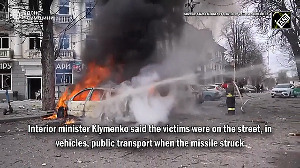Going by the proliferation of mass communication and journalism schools, it seems that news gathering has become a lucrative profession.
According to Imran Zahir, director of Delhi-based mass communication institute, Media Active, there are roughly 50 schools that teach journalism and related subjects in the capital alone. And more are coming up.
New Age Academy, a mass communication institute (with focus on television) based in Gurgaon will debut with a host of under graduate programmes in May.
Television software company, B A G Films promoted International School of Media and Entertainment Studies is likely to start sometime in end-July.
That month will also see Jaipuria Institute of Management commence its mass communication and journalism course. Pioneer Media School (from the publishers of The Pioneer) was launched barely six months back.
What's fuelling the boom in media institutes is the likelihood of a few more television news (as well as business) channels starting their operations soon.
Besides India TV and Sab Samachar, CNBC is likely to launch a Hindi business news channel. More action in radio is also expected.
The All India Radio will soon start a 24-hour news channel. The government is likely to lift the ban on news and current affairs programmes on private FM stations.
According to veteran journalist B G Verghese: "The whole media scene has changed. It's no more limited to print and broadcast journalism." He believes that professionals are needed to handle web pages, corporate newsletters and house journals. "The demand for trained writers and editors will only increase," he adds.
Agrees A Suryaprakash, director, Pioneer Media School: "In five years time there will be a convergence of various media. Print, audio-visual and Internet will all be criss-crossing each other's domains. We train our students to fit into this scenario."
Paranjoy Guha Thakurta, director, School of Convergence echoes the view: "The media professionals of the future must have knowledge of various media."
The curriculum at journalism school ranges from fundamentals of journalism, honing of writing and editing skills, basics of television journalism and media ethics and law.
The fee structures depend on individual institutes. Learning just print journalism costs much less compared to television.
At the Indian Institute of Mass Communication, Delhi, a year's course in print journalism costs Rs 19,000 while a three-year mass communication degree programme at Rai University comes with a price tag of Rs 270,000.
At most institutes courses are structured in such a way that after graduating, a student can choose a variety of professions in allied fields.
"You can't really teach journalism. It's a profession of instinct, more so, in print. But television journalism is more technical. The correspondent, besides reporting, also has to know what shots and bytes to edit. This is where we step in," says Rajan Guha, CEO, New Age Academy that charges Rs 99,000 for a year's diploma in broadcast journalism.
If journalism can't be taught, how relevant are these schools? While a senior editor of a national daily complains about the quality of students coming out of the media schools, IIMC's S Raghavachari puts the matter in perspective: "Even for big media houses it is not commercially viable to hire freshers and train them to be journalists. Media schools help in imparting the basic training. Currently, there are too many poorly-equipped schools and not such a demand for journalists."
What media school promoters are probably banking on are the estimates that suggest that the total turnover of India's ICE (information, communications and entertainment) sector will increase from Rs 84,000 crore (Rs 840 billion) in 2000 to Rs 2,00,000 crore (Rs 2,000 billion) in 2005 resulting in 500,000 jobs. And that means pots of money in the training ground.







 © 2025
© 2025